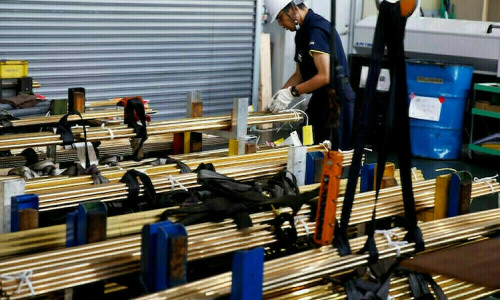China’s Factory Activity Shrinks at Record Pace
A recent survey revealed that China’s factory activity experienced its most significant contraction in 16 months during April. This downturn has intensified calls for additional economic stimulus, especially as new tariffs imposed by the United States disrupted a brief period of recovery.
The survey results present a contrasting view to the confidence expressed by Chinese officials regarding the nation’s ability to withstand trade pressures from the US. It also indicates that domestic demand remains soft, with manufacturers struggling to secure alternative international customers.
Initially, manufacturers accelerated export shipments in anticipation of the tariffs. However, the implementation of these tariffs has brought an end to this strategy, thereby increasing pressure on policymakers to rebalance the Chinese economy.
Key Findings of the PMI
The official Purchasing Managers’ Index (PMI) for China decreased to 49.0 in April from 50.5 in March, according to the National Bureau of Statistics (NBS). This is the lowest reading observed since December of the preceding year and falls short of the 49.8 median forecast from a recent poll.
The non-manufacturing PMI, which encompasses services and construction, saw a decrease to 50.4 from 50.8. However, it remained above the critical 50-mark, which distinguishes growth from contraction.
Expert Analysis
According to Zichun Huang, a China Economist at Capital Economics, the sharp decline in the PMIs likely exaggerates the immediate impact of tariffs due to prevailing negative sentiment. Nevertheless, it suggests that the Chinese economy is facing increasing pressure as external demand diminishes. Huang anticipates that despite increased government fiscal support, it is unlikely to completely offset the drag, forecasting an economic expansion of only 3.5% for the current year.
Huang also noted that the pessimism among survey respondents likely amplifies the actual effect of the tariffs. The new export orders index, excluding COVID-19 related disruptions, has dropped to its lowest level since April 2012.
Broader Economic Challenges
The US’s decision to impose import duties on Beijing comes at a particularly challenging period for China, which is grappling with deflation caused by sluggish income growth and a prolonged crisis in the property market.
Since the end of the pandemic, Beijing has primarily relied on exports to bolster its fragile economic recovery and only recently started taking more aggressive measures to stimulate domestic demand late last year.
Zhao Qinghe, a statistician at the NBS, stated that the decline is largely attributable to significant shifts in China’s external environment.
Additionally, a separate private sector survey released concurrently also indicated a notable decrease in new export orders and a slowdown in overall factory activity.
Following the release of the data, the Chinese yuan experienced a slight decrease against the dollar, as the initial data since the tariff announcement suggested preliminary signs of economic damage.
China’s Response Strategy
China has consistently denied any intent to negotiate a resolution to the tariffs with the US, seemingly preferring to wait for Washington to initiate the first move.
Consequently, Beijing has accelerated its stimulus plans for the current year to alleviate the economic repercussions of potentially losing its largest customer, even if temporarily.
Wang Qing, the chief macro analyst at Oriental Jincheng, anticipates that the manufacturing PMI will remain in contraction during May but is expected to increase to approximately 49.5, driven by an increase in stable growth policies. Wang suggests that further reductions in interest rates and reserve requirements for commercial banks may be necessary as conditions worsen.
Earlier this week, a senior official from China’s state planner announced that the National Development and Reform Commission (NDRC) would introduce new policies throughout the second quarter, tailored to the prevailing economic conditions.
These announcements followed pledges made by the Communist Party’s Politburo to support businesses and workers most affected by the tariffs.
While a general consensus among China observers is that a renewed trade conflict with the US will significantly impact growth, Zhao Chenxin from the NDRC expressed confidence that the country would achieve its economic growth target of around 5% by 2025.
However, the International Monetary Fund, Goldman Sachs, and UBS have all recently lowered their economic growth forecasts for China through 2026, citing the impact of US tariffs, with none expecting the economy to meet Beijing’s official growth target.



Comments (0)
No comments yet. Be the first to comment!
Leave a Comment